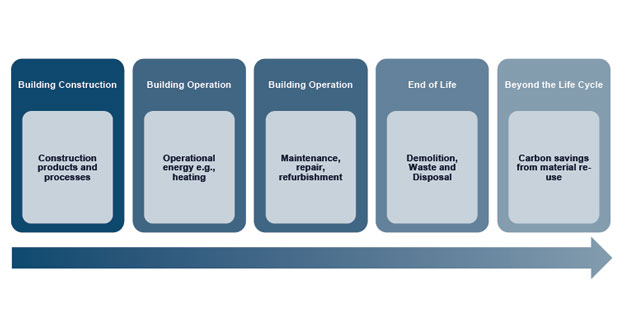Kieran King, Sustainability Consultant for the SFMI & Acclaro Advisory on ways to help close the potential gap in building life-cycle emissions, where FM Scope 3 is currently excluded
There has been a recent rise in companies beginning to look at their wider emissions footprint, fuelled by increased scrutiny of emission disclosures. Previously, focus has been limited to emissions with easily accessible data – Scope 1 and 2 (typically natural gas, electricity, fleet vehicles, diesel and refrigerant gases). However, with recently published figures from reporting bodies such as CDP, estimating that up to 95 per cent of a company’s emissions reside within their supply chain and wider upstream and downstream activities (Scope 3), the spotlight has shifted.
In the UK, the built environment accounts for up to 25 per cent of total emissions each year, with the recent Government reports highlighting the sector as one of the more challenging to meet net zero targets. The below traditional framework looks at four key areas for a building’s carbon emissions: construction, operation (or use), end of life and beyond the lifecycle. However, as can be seen from the below figure, traditional frameworks exclude Facilities Management (FM) emissions.
Figure 1: Traditional Framework infographic for built environment emissions
THE PROBLEM WITH ACCOUNTING FOR FM ACTIVITIES
When calculating the emissions for the operational phase of a building, FM emissions are excluded. This is because these emissions are looked at through the lens of building ownership, and as FM providers do not own the buildings they are contracted to work in, their emissions are not included. As can be seen from the above graphic, there are clear areas of a building’s operational footprint that FM contribute to, such as cleaning, security and grounds management. But as the current ownership scope is applied, and outsourced building management is excluded, the FM Scope 3 emissions are ignored.
Table 1 shows the key emissions that are currently excluded from scope using traditional frameworks. As can be seen from the list, there are areas that have the potential to be generating significant emissions that are currently overlooked.
|
Scope 3 FM Emissions |
Purchased Goods and Services |
Products & services to support service delivery on client site that are procured by the FM provider |
|
Fuel and Energy Related Activities |
Transmission & distribution losses from electricity |
|
|
Upstream Transportation and Distribution |
Logistics/couriers and delivery of materials |
|
|
Waste Generated in Operations |
Waste managed on client operations where FM is paid to manage waste and in projects delivered that generate waste |
|
|
Business Travel |
Travel relating to delivery of client services. |
|
|
Employee Commuting |
Commuting to client sites for on-site teams |
|
|
Upstream Leased Assets |
Emissions from renting specialist equipment for delivery of services |
Table 1: List of key FM emissions currently excluded from Building Life-Cycle Carbon Assessment
ACTIONS FM CAN TAKE TO DEVELOP ITS FOOTPRINT
The significance of FM Scope 3 emissions is currently unknown, so the first step should be data collection. For data collection, FM providers should first look at their own operations to determine which Scope 3 categories are relevant to their business and associated contracts.
To collect this data, the SFMI has worked with an industry team to develop a GHG Standard for the FM Sector, proposing two practical solutions. Either a top-down method which focuses on collecting Scope 1, 2 and 3 data at a corporate level. Or, bottom-up which is focused on customer allocation, with footprints built at a contract level, where the FM provider has ownership, responsibility, or influence over the emissions.
FM has the chance to play a critical role in the next phase – emissions reductions at the service level. Particularly with the bottom-up approach, once key areas for reductions have been identified, the FM provider can work closely with their customer to develop a plan for emissions reductions. This may be by altering the products that are procured to deliver a service, incorporating nature-based solutions into grounds maintenance or increasing maintenance schedules to ensure IT equipment is running as efficiently as possible. These improvements provide FM companies with a significant opportunity to integrate themselves more closely with their customers.
The revelation of the gap in building life-cycle emissions means FM has a critical role to play in data collection, analysis, and emissions reductions in relation to the FM Operational footprint. It is vital that FM companies begin to measure and monitor their Scope 3, at both a corporate and contract level, so that we may begin to understand their significance.
Indeed, as the Parliament’s Environmental Audit Committee (EAC) ramps up its focus on the built environment, the need to get emissions foot printing right, and ensure the scope is complete, has never been more vital. Only once the full scope of the built environment carbon footprint is clear can we focus on driving emissions reductions at scale. Whilst we are at the beginning of this journey, the steps laid out below shows a clear path to success.
Figure 2: Path to success, showing key stages for measuring, integrating, and reducing FM scope 3 emissions.
To read the full Scope 3 report, please visit the Acclaro Advisory website – www.acclaro-advisory.com






